Urbanization Effects on Human-Perceived Temperature Changes in the North China Plain
Abstract
1. Introduction
2. Materials and Methods
2.1. Study Area
2.2. Definition of Human-Perceived Temperatures
2.3. Data Sources
2.4. Methods
3. Results and Discussion
3.1. Spatial Distribution of Changes in Temperatures
3.2. Temporal Evolution of Regional Mean Temperature
3.3. Urbanization Effect and its Implications
4. Conclusions
- During 1976–2016, all temperature indicators show significantly increasing trends over the whole study area, among which HI and WCT show higher warming trends than T, indicating that human-perceived temperatures increase faster than T. The warming trend in winter is higher than that in summer.
- Human-perceived temperatures show higher increasing trends in urban areas than in non-urban areas, implying more thermal discomfort in summer and slightly more thermal comfort in winter, especially in urban areas. The warming trends in period-2 (1996–2016) are lower than those in period-1 (1976–1995), partly due to the global surface warming hiatus.
- For the entire study area, 26% of the increase in HI and 17% of the increase in WCT are attributed to urbanization and associated urban land expansion. The UE is much larger in the south than in the north, divided by the boundary of 35°N.
Author Contributions
Funding
Conflicts of Interest
Appendix A
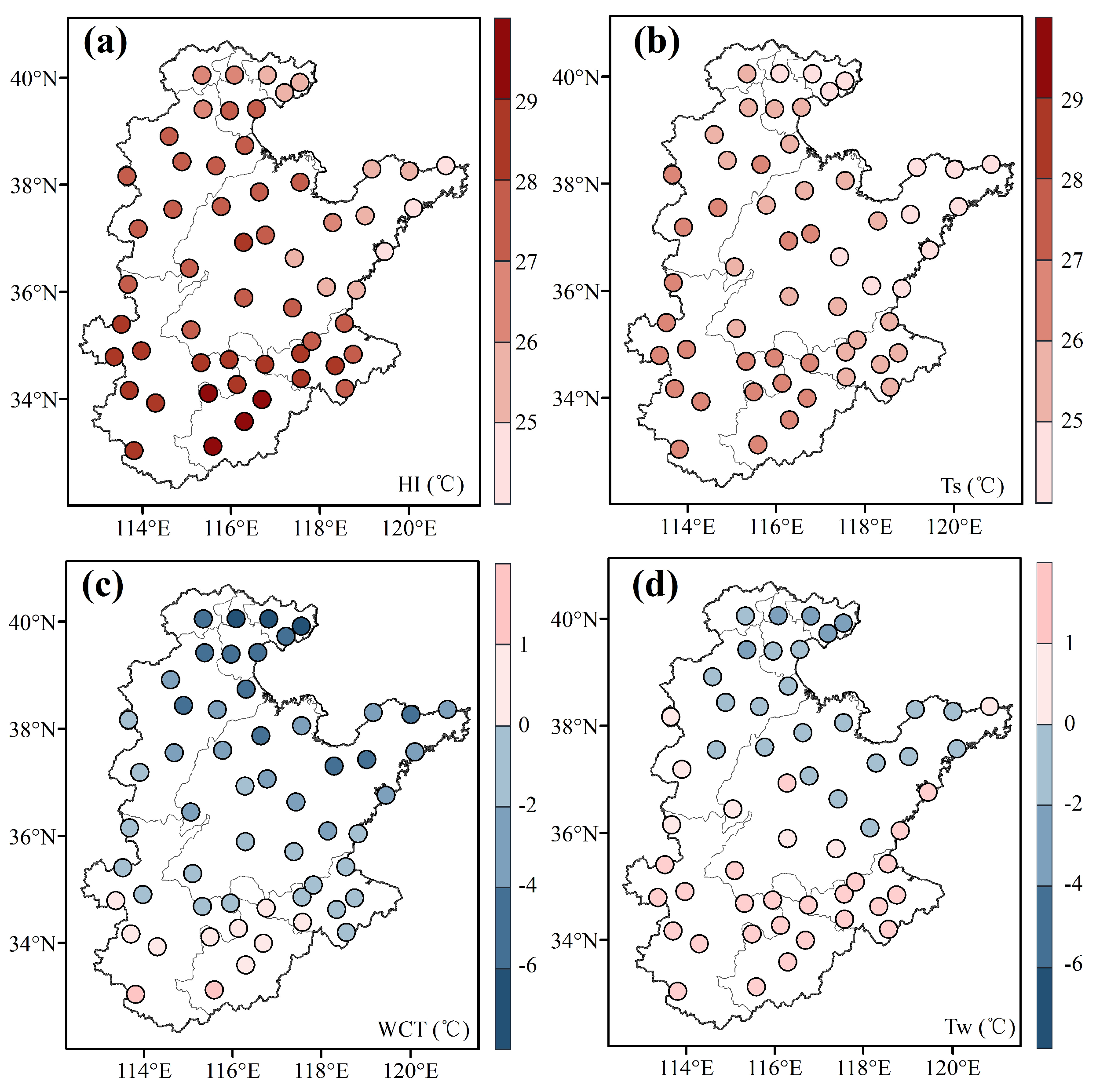
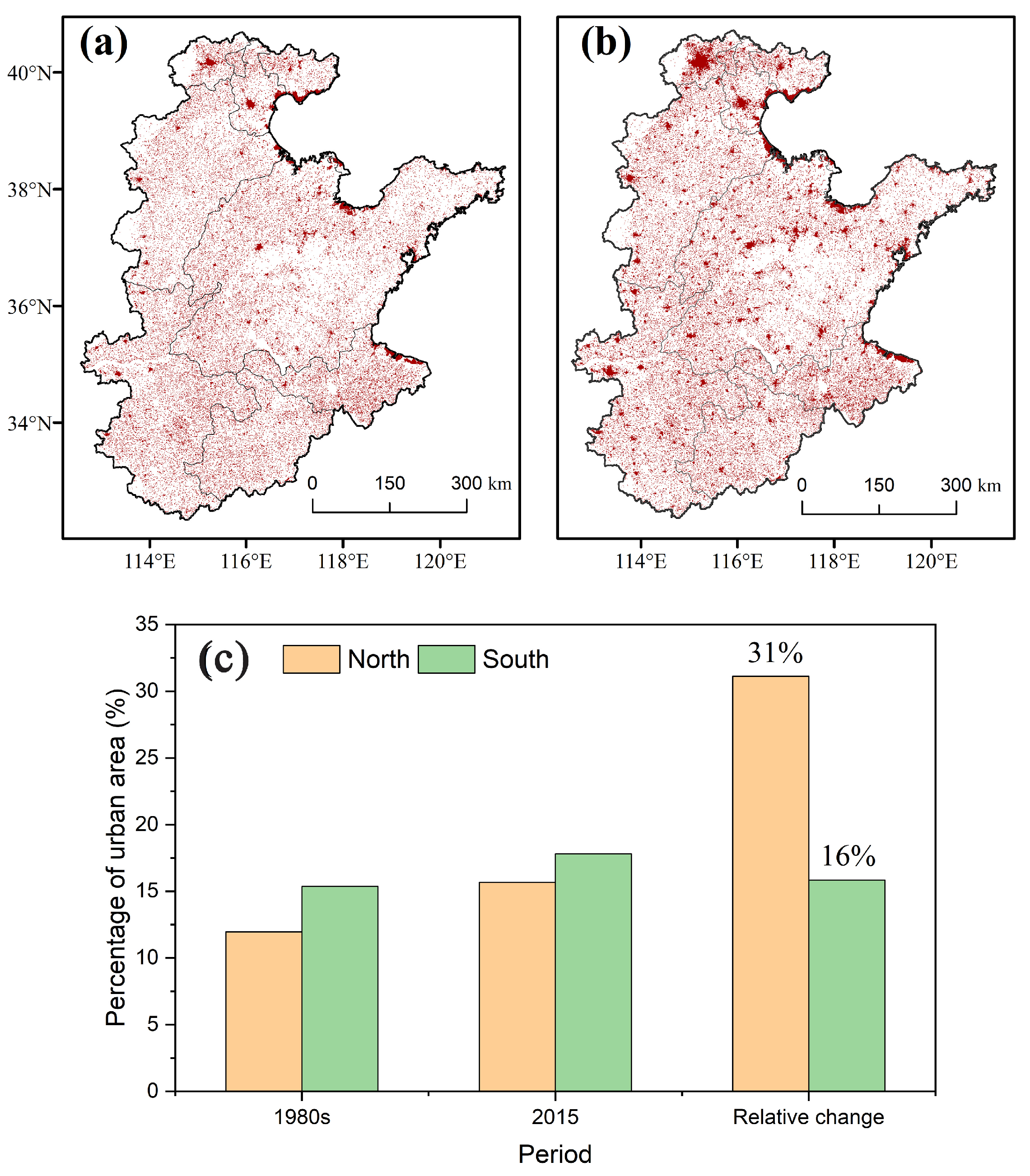
| Sub-Period | HI | Ts | WCT | Tw | RHs | WSw |
|---|---|---|---|---|---|---|
| Period-1 | 0.30 | 0.18 | 1.05 | 0.67 | 0.43 | −0.31 |
| Period-2 | 0.07 | 0.10 | 0.22 | −0.03 | −1.27 | −0.28 |
References
- Mishra, V.; Ganguly, A.R.; Nijssen, B.; Lettenmaier, D.P. Changes in observed climate extremes in global urban areas. Environ. Res. Lett. 2015, 10, 024005. [Google Scholar] [CrossRef]
- Kalnay, E.; Cai, M. Impact of urbanization and land-use change on climate. Nature 2003, 423, 528–531. [Google Scholar] [CrossRef]
- Birch, E.L.; Wachter, S.M. (Eds.) Global Urbanization; University of Pennsylvania Press: Philadelphia, PA, USA, 2011. [Google Scholar] [CrossRef]
- United Nations Department of Public Information. World Urbanization Prospects 2018; UN Department of Public Information: New York, NY, USA, 2018. [Google Scholar]
- Rosenzweig, C.; Solecki, W.D.; Romero-Lankao, P.; Mehrotra, S.; Dhakal, S.; Ibrahim, S.A. Climate Change and Cities: Second Assessment Report of the Urban Climate Change Research Network; Cambridge University Press: Cambridge, UK, 2018. [Google Scholar]
- Patz, J.A.; Campbell-Lendrum, D.; Holloway, T.; Foley, J.A. Impact of regional climate change on human health. Nature 2005, 438, 310–317. [Google Scholar] [CrossRef] [PubMed]
- Barnett, A.G.; Hajat, S.; Gasparrini, A.; Rocklöv, J. Cold and heat waves in the United States. Environ. Res. 2012, 112, 218–224. [Google Scholar] [CrossRef] [PubMed]
- Pienimaki, T. Cold exposure and musculoskeletal disorders and diseases. A review. Int. J. Circumpolar Health 2002, 61, 173–182. [Google Scholar] [CrossRef] [PubMed]
- Kovats, R.S.; Hajat, S. Heat stress and public health: A critical review. Annu. Rev. Public Health 2008, 29, 41–55. [Google Scholar] [CrossRef] [PubMed]
- Christina, K.; Kovats, R.S.; Bettina, M.; Gerd, J. Heat-Waves: Risks and Responses; World Health Organization, Regional Office for Europe: Copenhagen, Denmark, 2004. [Google Scholar]
- Holmér, I. Evaluation of cold workplaces: An overview of standards for assessment of cold stress. Ind. Health 2009, 47, 228–234. [Google Scholar] [CrossRef] [PubMed]
- McMichael, A.J.; Woodruff, R.E.; Hales, S. Climate change and human health: Present and future risks. Lancet 2006, 367, 859–869. [Google Scholar] [CrossRef]
- Castellani, J.W.; Young, A.J. Human physiological responses to cold exposure: Acute responses and acclimatization to prolonged exposure. Auton. Neurosci. 2016, 196, 63–74. [Google Scholar] [CrossRef]
- Jin, K.; Wang, F.; Chen, D.; Jiao, Q.; Xia, L.; Fleskens, L.; Mu, X. Assessment of urban effect on observed warming trends during 1955–2012 over China: A case of 45 cities. Clim. Chang. 2015, 132, 631–643. [Google Scholar] [CrossRef]
- Ye, H.; Huang, Z.; Huang, L.; Lin, L.; Luo, M. Effects of urbanization on increasing heat risks in South China. Int. J. Climatol. 2018, 38, 5551–5562. [Google Scholar] [CrossRef]
- Li, J.; Song, C.; Cao, L.; Zhu, F.; Meng, X.; Wu, J. Impacts of landscape structure on surface urban heat islands: A case study of Shanghai, China. Remote Sens. Environ. 2011, 115, 3249–3263. [Google Scholar] [CrossRef]
- Ren, G.; Zhou, Y. Urbanization Effect on Trends of Extreme Temperature Indices of National Stations over Mainland China, 1961–2008. J. Clim. 2014, 27, 2340–2360. [Google Scholar] [CrossRef]
- Oke, T.R. The energetic basis of the urban heat island. Q. J. R. Meteorol. Soc. 1982, 108, 1–24. [Google Scholar] [CrossRef]
- Oleson, K.W.; Anderson, G.B.; Jones, B.; McGinnis, S.A.; Sanderson, B. Avoided climate impacts of urban and rural heat and cold waves over the U.S. using large climate model ensembles for RCP8.5 and RCP4.5. Clim. Chang. 2018, 146, 377–392. [Google Scholar] [CrossRef] [PubMed]
- Werner, H.T.; Stella, S.-F.L. Solar radiation and urban heat islands. Ann. Assoc. Am. Geogr. 1973, 63, 181–207. [Google Scholar]
- Ramamurthy, P.; Bou-Zeid, E. Contribution of impervious surfaces to urban evaporation. Water Resour. Res. 2014, 50, 2889–2902. [Google Scholar] [CrossRef]
- Yuan, F.; Bauer, M.E. Comparison of impervious surface area and normalized difference vegetation index as indicators of surface urban heat island effects in Landsat imagery. Remote Sens. Environ. 2007, 106, 375–386. [Google Scholar] [CrossRef]
- Stewart, I.D.; Oke, T.R. Local Climate Zones for Urban Temperature Studies. Bull. Am. Meteorol. Soc. 2012, 93, 1879–1900. [Google Scholar] [CrossRef]
- Rothfusz, L.P. The Heat Index Equation (or, More Than You ever Wanted to Know about Heat Index); National Oceanic and Atmospheric Administration, National Weather Service, Office of Meteorology: Fort Worth, TX, USA, 1990.
- Osczevski, R.J. The basis of wind chill. Arctic 1995, 48, 372–382. [Google Scholar] [CrossRef]
- Li, J.; Chen, Y.D.; Gan, T.Y.; Lau, N.-C. Elevated increases in human-perceived temperature under climate warming. Nat. Clim. Chang. 2018, 8, 43–47. [Google Scholar] [CrossRef]
- Luo, M.; Lau, N.C. Increasing Heat Stress in Urban Areas of Eastern China: Acceleration by Urbanization. Geophys. Res. Lett. 2018. [Google Scholar] [CrossRef]
- Feng, S.; Gong, D.; Zhang, Z.; He, X.; Guo, D.; Lei, Y. Wind-chill temperature changes in winter over China during the last 50 years. Acta Geogr. Sin. 2009, 64, 1071–1082. [Google Scholar]
- Pal, J.S.; Eltahir, E.A.B. Future temperature in southwest Asia projected to exceed a threshold for human adaptability. Nat. Clim. Chang. 2015, 6, 197–200. [Google Scholar] [CrossRef]
- Willett, K.M.; Sherwood, S. Exceedance of heat index thresholds for 15 regions under a warming climate using the wet-bulb globe temperature. Int. J. Climatol. 2012, 32, 161–177. [Google Scholar] [CrossRef]
- Wang, Y.; Chen, L.; Song, Z.; Huang, Z.; Ge, E.; Lin, L.; Luo, M. Human-perceived temperature changes over South China: Long-term trends and urbanization effects. Atmos. Res. 2019, 215, 116–127. [Google Scholar] [CrossRef]
- Carder, M.; McNamee, R.; Beverland, I.; Elton, R.; Cohen, G.R.; Boyd, J.; Agius, R.M. The lagged effect of cold temperature and wind chill on cardiorespiratory mortality in Scotland. Occup. Environ. Med. 2005, 62, 702–710. [Google Scholar] [CrossRef]
- Liu, L.; Breitner, S.; Pan, X.; Franck, U.; Leitte, A.M.; Wiedensohler, A.; von Klot, S.; Wichmann, H.-E.; Peters, A.; Schneider, A. Associations between air temperature and cardio-respiratory mortality in the urban area of Beijing, China: A time-series analysis. Environ. Health 2011, 10, 51. [Google Scholar] [CrossRef]
- Guo, Y.; Barnett, A.G.; Pan, X.; Yu, W.; Tong, S. The impact of temperature on mortality in Tianjin, China: A case-crossover design with a distributed lag nonlinear model. Environ. Health Perspect. 2011, 119, 1719–1725. [Google Scholar] [CrossRef]
- Tian, Z.; Li, S.; Zhang, J.; Jaakkola, J.J.; Guo, Y. Ambient temperature and coronary heart disease mortality in Beijing, China: A time series study. Environ. Health 2012, 11, 56. [Google Scholar] [CrossRef]
- Desideri, U.; Proietti, S.; Sdringola, P. Solar-powered cooling systems: Technical and economic analysis on industrial refrigeration and air-conditioning applications. Appl. Energy 2009, 86, 1376–1386. [Google Scholar] [CrossRef]
- Rezaie, B.; Rosen, M.A. District heating and cooling: Review of technology and potential enhancements. Appl. Energy 2012, 93, 2–10. [Google Scholar] [CrossRef]
- Lou, S.; Yang, Y.; Wang, H.; Smith, S.J.; Qian, Y.; Rasch, P.J. Black Carbon Amplifies Haze Over the North China Plain by Weakening the East Asian Winter Monsoon. Geophys. Res. Lett. 2019, 46, 452–460. [Google Scholar] [CrossRef]
- Yang, X.; Ruby Leung, L.; Zhao, N.; Zhao, C.; Qian, Y.; Hu, K.; Liu, X.; Chen, B. Contribution of urbanization to the increase of extreme heat events in an urban agglomeration in east China. Geophys. Res. Lett. 2017, 44, 6940–6950. [Google Scholar] [CrossRef]
- Sun, Y.; Zhang, X.; Ren, G.; Zwiers, F.W.; Hu, T. Contribution of urbanization to warming in China. Nat. Clim. Chang. 2016, 6, 706–709. [Google Scholar] [CrossRef]
- Bian, T.; Ren, G.; Yue, Y. Effect of Urbanization on Land-Surface Temperature at an Urban Climate Station in North China. Bound. Layer Meteorol. 2017, 165, 553–567. [Google Scholar] [CrossRef]
- Kang, S.; Eltahir, E.A.B. North China Plain threatened by deadly heatwaves due to climate change and irrigation. Nat. Commun. 2018, 9, 2894. [Google Scholar] [CrossRef] [PubMed]
- Wei, B.; Xie, Y.; Jia, X.; Wang, X.; He, H.; Xue, X. Land use/land cover change and it’s impacts on diurnal temperature range over the agricultural pastoral ecotone of Northern China. Land Degrad. Dev. 2018, 29, 3009–3020. [Google Scholar] [CrossRef]
- Mekis, É.; Vincent, L.A.; Shephard, M.W.; Zhang, X. Observed Trends in Severe Weather Conditions Based on Humidex, Wind Chill, and Heavy Rainfall Events in Canada for 1953–2012. Atmos. Ocean 2015, 53, 383–397. [Google Scholar] [CrossRef]
- Xu, X.; Liu, J.; Zhang, S.; Li, R.; Yan, C.; Wu, S. China’s Multi-Period Land Use Land Cover Remote Sensing Monitoring Dataset (CNLUCC); Chinese Academy of Sciences Resource and Environmental Science Data Center Data Registration and Publishing System: Beijing, China, 2018. [Google Scholar]
- Xu, X. China Population Spatial Distribution Kilometer Grid Dataset; Data Registration and Publishing System of the Resource and Environmental Science Data Center of the Chinese Academy of Sciences: Beijing, China, 2017. [Google Scholar]
- Hamed, K.H.; Rao, A.R. A modified Mann-Kendall trend test for autocorrelated data. J. Hydrol. 1998, 204, 182–196. [Google Scholar] [CrossRef]
- Bond, T.C.; Doherty, S.J.; Fahey, D.W.; Forster, P.M.; Berntsen, T.; DeAngelo, B.J.; Flanner, M.G.; Ghan, S.; Kärcher, B.; Koch, D.; et al. Bounding the role of black carbon in the climate system: A scientific assessment. J. Geophys. Res. Atmos. 2013, 118, 5380–5552. [Google Scholar] [CrossRef]
- Liu, B.; Xu, M.; Henderson, M.; Qi, Y.; Li, Y. Taking China’s temperature: Daily range, warming trends, and regional variations, 1955–2000. J. Clim. 2004, 17, 4453–4462. [Google Scholar] [CrossRef]
- Xu, M.; Chang, C.-P.; Fu, C.; Qi, Y.; Robock, A.; Robinson, D.; Zhang, H.-M. Steady decline of east Asian monsoon winds, 1969–2000: Evidence from direct ground measurements of wind speed. J. Geophys. Res. 2006, 111. [Google Scholar] [CrossRef]
- Wu, J.; Zha, J.; Zhao, D.; Yang, Q. Changes in terrestrial near-surface wind speed and their possible causes: An overview. Clim. Dyn. 2017, 51, 2039–2078. [Google Scholar] [CrossRef]
- Huang, R.; Chen, J.; Wang, L.; Lin, Z. Characteristics, processes, and causes of the spatio-temporal variabilities of the East Asian monsoon system. Adv. Atmos. Sci. 2012, 29, 910–942. [Google Scholar] [CrossRef]
- Wu, J.; Gao, X.; Giorgi, F.; Chen, D. Changes of effective temperature and cold/hot days in late decades over China based on a high resolution gridded observation dataset. Int. J. Climatol. 2017, 37, 788–800. [Google Scholar] [CrossRef]
- Xie, Y.; Huang, J.; Liu, Y. From accelerated warming to warming hiatus in China. Int. J. Climatol. 2017, 37, 1758–1773. [Google Scholar] [CrossRef]
- Li, Q.; Yang, S.; Xu, W.; Wang, X.L.; Jones, P.; Parker, D.; Zhou, L.; Feng, Y.; Gao, Y. China experiencing the recent warming hiatus. Geophys. Res. Lett. 2015, 42, 889–898. [Google Scholar] [CrossRef]
- Intergovernmental Panel on Climate Change (IPCC). Climate Change 2013: The Physical Science Basis. In Contribution of Working Group I to the Fifth Assessment Report of the Intergovernmental Panel on Climate Change; Cambridge University Press: Cambridge, UK; New York, NY, USA, 2013. [Google Scholar]
- Horton, D.E.; Johnson, N.C.; Singh, D.; Swain, D.L.; Rajaratnam, B.; Diffenbaugh, N.S. Contribution of changes in atmospheric circulation patterns to extreme temperature trends. Nature 2015, 522, 465–469. [Google Scholar] [CrossRef]
- Wang, L.; Chen, W. A CMIP5 multimodel projection of future temperature, precipitation, and climatological drought in China. Int. J. Climatol. 2014, 34, 2059–2078. [Google Scholar] [CrossRef]
- Kühn, T.; Partanen, A.I.; Laakso, A.; Lu, Z.; Bergman, T.; Mikkonen, S.; Kokkola, H.; Korhonen, H.; Räisänen, P.; Streets, D.G.; et al. Climate impacts of changing aerosol emissions since 1996. Geophys. Res. Lett. 2014, 41, 4711–4718. [Google Scholar] [CrossRef]
- Xu, J.; Ding, L. A review of metro construction in China: Organization, market, cost, safety and schedule. Front. Eng. Manag. 2017, 4. [Google Scholar] [CrossRef]
- Grimm, N.B.; Faeth, S.H.; Golubiewski, N.E.; Redman, C.L.; Wu, J.; Bai, X.; Briggs, J.M. Global change and the ecology of cities. Science 2008, 319, 756–760. [Google Scholar] [CrossRef]
- Xue, Z.; Hou, G.; Zhang, Z.; Lyu, X.; Jiang, M.; Zou, Y.; Shen, X.; Wang, J.; Liu, X. Quantifying the cooling-effects of urban and peri-urban wetlands using remote sensing data: Case study of cities of Northeast China. Landsc. Urban Plan. 2019, 182, 92–100. [Google Scholar] [CrossRef]
- Susca, T.; Gaffin, S.R.; Dell’osso, G.R. Positive effects of vegetation: Urban heat island and green roofs. Environ. Pollut. 2011, 159, 2119–2126. [Google Scholar] [CrossRef] [PubMed]
- Oliveira, S.; Andrade, H.; Vaz, T. The cooling effect of green spaces as a contribution to the mitigation of urban heat: A case study in Lisbon. Build. Environ. 2011, 46, 2186–2194. [Google Scholar] [CrossRef]
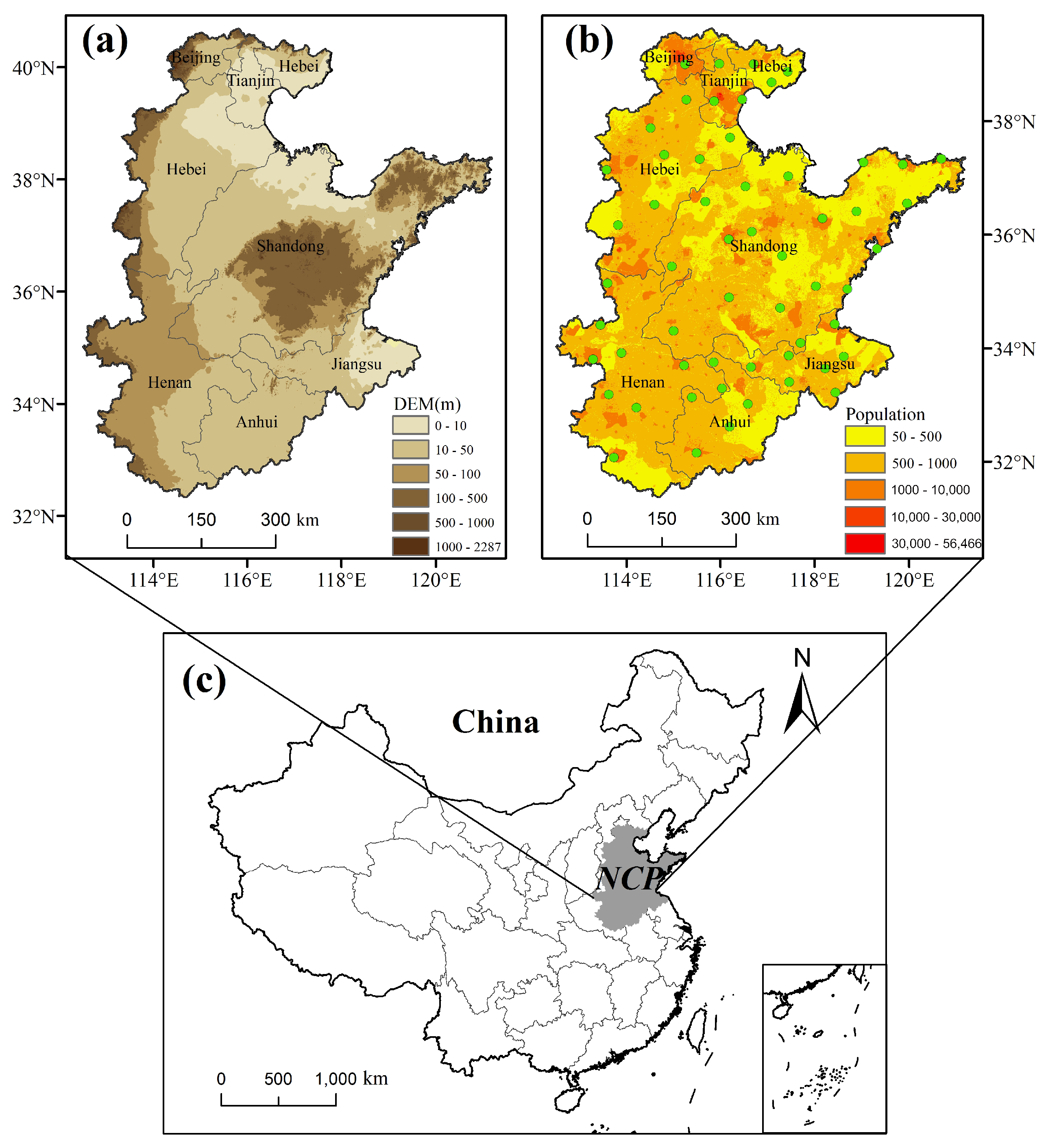
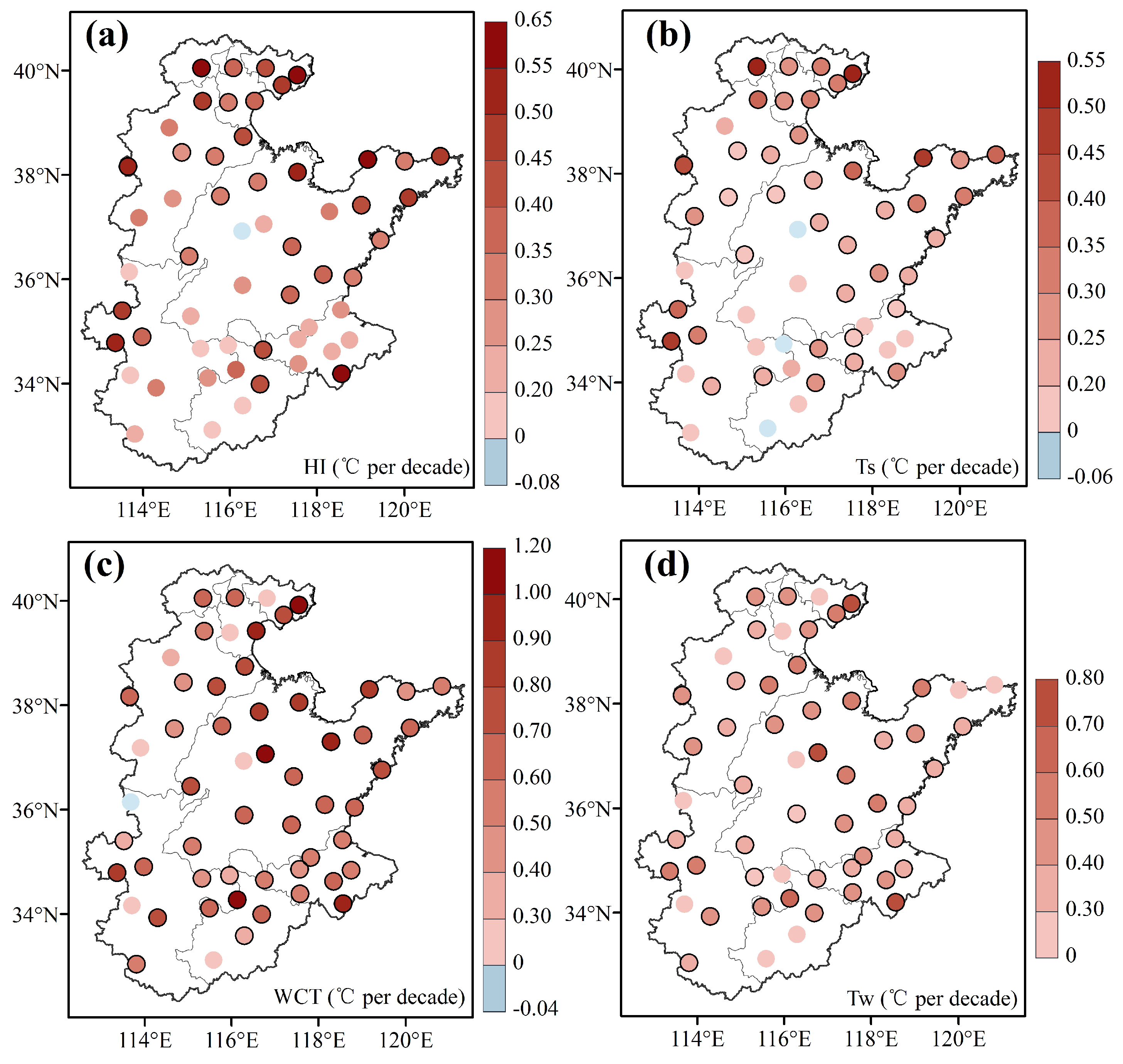

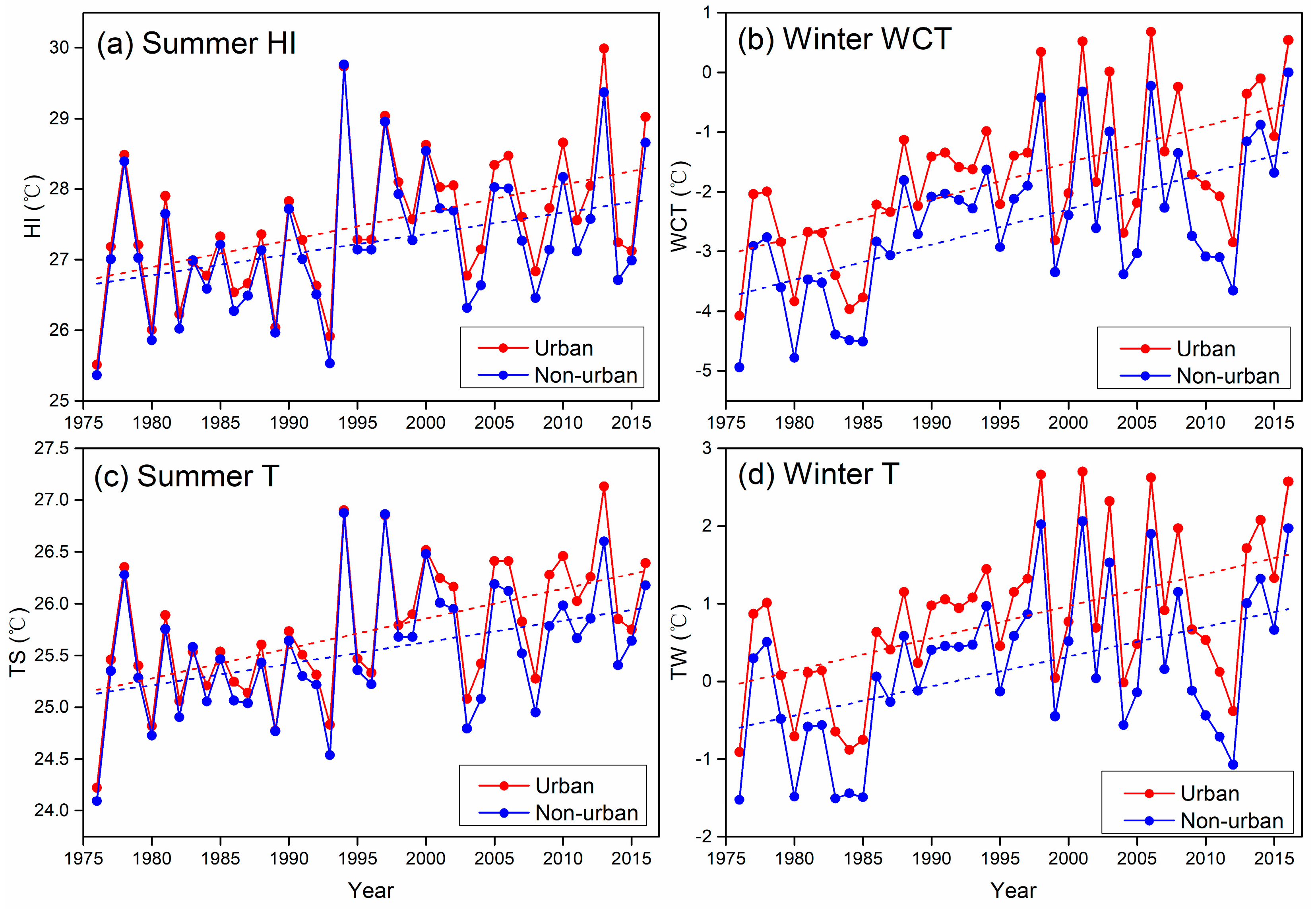

| Indicators | Definition | Unit |
|---|---|---|
| HI | Heat index | °C |
| WCT | Wind chill temperature | °C |
| T | Daily mean temperature | °C |
| RH | Relative humidity | % |
| WS | Wind speed | m/s |
| Region | Indicators | Summer | Winter | ||||||||
|---|---|---|---|---|---|---|---|---|---|---|---|
| Whole | Urban | Non-Urban | UE | UC (%) | Whole | Urban | Non-Urban | UE | UC (%) | ||
| Whole | HI/WCT | 0.35 | 0.40 | 0.30 | 0.10 | 26 | 0.64 | 0.70 | 0.58 | 0.12 | 17 |
| T | 0.25 | 0.30 | 0.21 | 0.09 | 31 | 0.42 | 0.47 | 0.38 | 0.08 | 18 | |
| RH | −0.96 | −1.27 | −0.66 | −0.45 | −0.71 | −0.18 | |||||
| WS | −0.16 | −0.16 | −0.17 | −0.18 | −0.20 | −0.16 | |||||
| North | HI/WCT | 0.39 | 0.39 | 0.38 | 0.00 | 1 | 0.65 | 0.68 | 0.61 | 0.07 | 10 |
| T | 0.29 | 0.30 | 0.28 | 0.02 | 7 | 0.42 | 0.43 | 0.40 | 0.03 | 7 | |
| RH | −1.03 | −1.23 | −0.84 | −0.32 | −0.67 | 0.02 | |||||
| WS | −0.17 | −0.19 | −0.14 | −0.20 | −0.22 | −0.18 | |||||
| South | HI/WCT | 0.32 | 0.42 | 0.21 | 0.21 | 49 | 0.64 | 0.73 | 0.55 | 0.18 | 25 |
| T | 0.22 | 0.30 | 0.13 | 0.16 | 55 | 0.43 | 0.50 | 0.36 | 0.14 | 28 | |
| RH | −0.89 | −1.32 | −0.47 | −0.57 | −0.76 | −0.37 | |||||
| WS | −0.16 | −0.13 | −0.20 | −0.16 | −0.17 | −0.15 | |||||
© 2019 by the authors. Licensee MDPI, Basel, Switzerland. This article is an open access article distributed under the terms and conditions of the Creative Commons Attribution (CC BY) license (http://creativecommons.org/licenses/by/4.0/).
Share and Cite
Wang, F.; Duan, K.; Zou, L. Urbanization Effects on Human-Perceived Temperature Changes in the North China Plain. Sustainability 2019, 11, 3413. https://doi.org/10.3390/su11123413
Wang F, Duan K, Zou L. Urbanization Effects on Human-Perceived Temperature Changes in the North China Plain. Sustainability. 2019; 11(12):3413. https://doi.org/10.3390/su11123413
Chicago/Turabian StyleWang, Feiyu, Keqin Duan, and Lei Zou. 2019. "Urbanization Effects on Human-Perceived Temperature Changes in the North China Plain" Sustainability 11, no. 12: 3413. https://doi.org/10.3390/su11123413
APA StyleWang, F., Duan, K., & Zou, L. (2019). Urbanization Effects on Human-Perceived Temperature Changes in the North China Plain. Sustainability, 11(12), 3413. https://doi.org/10.3390/su11123413






